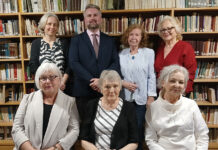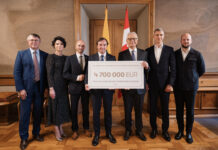
Sapiega Palace (Sapiegų rūmai) is a High Baroque palace in Sapiegos str., Antakalnis district of Vilnius, Lithuania. It is the only surviving palace of several formerly belonging to the Sapiega family in the city. The palace is surrounded by the remains of the 17th-century formal park. The impressive Baroque gate secures the entrance to the park from Antakalnis street, and the other gate is on the opposite side of the park, near the palace. Both of them were restored in 2012.
Six years ago, the property was handed over to the Contemporary Art Centre. After extensive restoration work, the Sapiega Palace in Vilnius is soon to be opened to the public as an art space.
 The palace was constructed in the late seventeenth century as a country residence for Jonas Kazimieras Sapiega the younger, a military commander of the Grand Duchy of Lithuania. It took the place of the former wooden mansion of Leonas Sapiega (who died there in 1633). The palace was designed by Giovanni Pietro Perti and decorated with frescoes by Michelangelo Palloni. The main floor initially displayed Dutch tiles and mosaics representing heraldry, churches, castles, and palaces owned or built by the Sapiegas. By having the palace built, Jonas Kazimieras Sapiega wished to show his power and ability to be a Grand Duke of Lithuania and King of Poland. The days of the Sapiega Palace’s grandeur ended after most of the Grand Duchy and Vilnius were annexed by the Russian Empire.
The palace was constructed in the late seventeenth century as a country residence for Jonas Kazimieras Sapiega the younger, a military commander of the Grand Duchy of Lithuania. It took the place of the former wooden mansion of Leonas Sapiega (who died there in 1633). The palace was designed by Giovanni Pietro Perti and decorated with frescoes by Michelangelo Palloni. The main floor initially displayed Dutch tiles and mosaics representing heraldry, churches, castles, and palaces owned or built by the Sapiegas. By having the palace built, Jonas Kazimieras Sapiega wished to show his power and ability to be a Grand Duke of Lithuania and King of Poland. The days of the Sapiega Palace’s grandeur ended after most of the Grand Duchy and Vilnius were annexed by the Russian Empire.
The exterior of the palace was restored in 1927-1928 and the building housed Vilnius University‘s ophthalmology institute until World War II. After the war, it was used as a military hospital and fell into disrepair. Since 2012, the palace has been undergoing restoration, in an attempt to bring it as close as possible to its original Baroque appearance.
Its director says the centre will seek to combine contemporary art and history. “Of course, we are first envisaging exhibitions of contemporary art, but not just exhibitions, events, concerts, but we’re also talking about contemporary dance, even circus, because it has this great hall,” says Contemporary Art Centre director Kęstutis Kuizinas. “There are not that many buildings in Lithuania where the ceiling height is 10 metres.”
Evaldas Purlys, who led the architectural research and restoration of the building, says that the most important thing was to preserve the palace’s authentic architecture, not to alter its interior spaces, the building plan, the façade. “It was more about exposing, about leaving what is most important, what has survived from the 16th, 17th, 18th centuries, and covering up what came later,” he says.
The restorers uncovered old frescoes. Two of them date back to the time of the Sapiega family, the 18th century. “We can trace the arrival of certain fashions and orientalist motifs to Lithuania, which is why we see in the frescoes, for example, people dressed in Muslim headgear, and even parrots, which were undoubtedly an exotic sight in Lithuania at the time,” says Kuizinas. Although the palace is to be opened to the public in spring, restoration and research will continue.
“The decoration of the palace during the Baroque period was contributed by craftsmen who were very important to us in Lithuania, such as Ferdiani, Paloni, and Petro Perti,” says Laura Misiūnaitė, the education program curator. “People who worked in other churches, monasteries, other mansions and palaces in Vilnius, in the Grand Duchy of Lithuania, and in Poland.”
The Sapiega Palace will open to the public on April 12. Tours of the building will be available between February 16 and March 11. The palace offers over 2,000 square meters of space for artistic expression and will host exhibitions, concerts, theatre performances, and circus shows. The restored palace, with its preserved frescoes and authentic architecture, promises to be more than a gallery; it will be a living testament to the transformative power of art and the resilience of history.



























